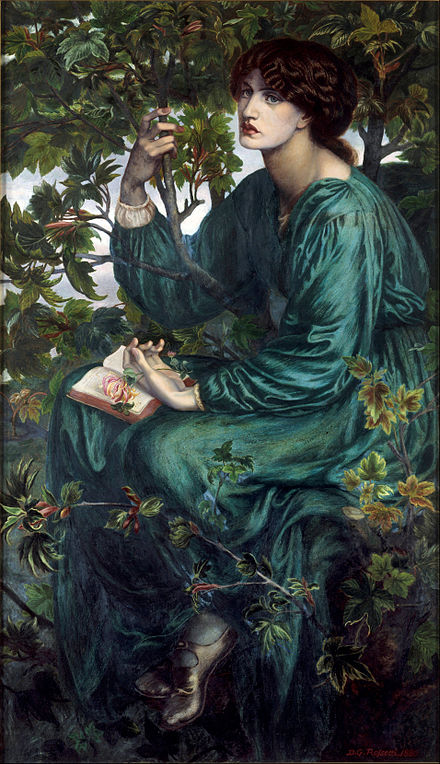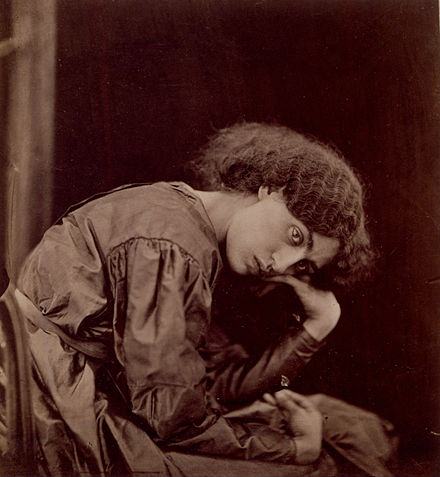The real “Pygmalion”? – Jane Burden Morris
[NOTE: I noticed that last night commenter “Zaphod” brought up Jane Morris towards the end of the open thread (see this as well as this). I thought I’d respond by putting up a link to an ealier post of mine on Jane Morris, but when I looked for it I was surprised to find no such post existed. It was actually in draft form, along with about a thousand other unpublished posts of mine.
Yes, you read that right – about a thousand. It amounts to a severe case of post-hoarding – as I wrote over three years ago, when the number of hoarded posts was about half what it is today. In that piece on post-hoarding, I described three categories of hoarded posts, but I now realize I should add a fourth: posts that started out sounding interesting but didn’t quite pass muster once I’d fleshed them out.
My post about Jane Morris is one of that latter group. And yet, after reading Zaphod’s comment, I’ve decided to liberate it from bondage and put it out here despite that. Why not? At least, it’s a break from politics. So here it is.]
You know how it goes. You’re researching something, way leads on to way, and suddenly you’ve stumbled on an altogether different but fascinating story. This happened to me recently when I was researching some artwork for a post, and I came across the story of Jane Morris, who turns out to have been not only an artist’s model and the wife of William Morris, but was probably the model for Eliza Doolittle in “Pygmalion” and “My Fair Lady”:
Burden was born in Oxford, the daughter of a stableman, Robert Burden, and his wife Ann Maizey, who was a laundress…Her mother Ann was illiterate and probably came to Oxford as a domestic servant. Little is known of Jane Burden’s childhood, but it was poor and deprived.
In October 1857, Burden and her sister Elizabeth, known as “Bessie”, attended a performance of the Drury Lane Theatre Company in Oxford. Jane Burden was noticed by Dante Gabriel Rossetti and Edward Burne-Jones who were members of a group of artists painting the Oxford Union murals, based on Arthurian tales. Struck by her beauty, they asked her to model for them. Burden sat mostly for Rossetti as a model for Queen Guinevere and afterwards for William Morris, who was working on an easel painting, La Belle Iseult, now in the Tate Gallery. Like Rossetti, Morris used Burden as the model for his painting of Queen Guinevere. During this period, Morris fell in love with Burden and they became engaged, though by her own admission she was not in love with Morris.
Burden’s education was limited and she was probably destined to go into domestic service like her mother. After her engagement, she was privately educated to become a rich gentleman’s wife. Her keen intelligence allowed her to recreate herself. She was a voracious reader who became proficient in French and Italian and became an accomplished pianist with a strong background in classical music. Her manners and speech became refined to an extent that contemporaries referred to her as “Queenly”. Later in life, she had no trouble moving in upper class circles. She was possibly the model for the heroine in the 1884 novel Miss Brown by Vernon Lee upon which was based the character of Eliza Doolittle in Bernard Shaw’s play Pygmalion (1914) and the later film My Fair Lady. She also became a skilled needlewoman who would be later renowned for her embroideries.
Here’s a painting by Rossetti for which Jane modeled:
She has the “look” beloved by the pre-Raphaelite group of painters. The features and hair seem exaggerated, don’t they, to create a certain dramatic impression? But actually, Burden really did look like that. Here’s a photograph of Burden taken in 1865:
An even more dramatic description of her reversal of fortune, and her looks, can be found in Paris Review:
…Janey’s habitual unsmiling expression, seen in paintings and photographs alike, conveys neither regret nor contrition. Instead, Rossetti captures the very quality that made this reserved and intelligent woman so captivating as a model: the suggestion of a complicated, closely guarded inner life behind the saturnine composition of her features…
[After her discovery by the pre-Raphaelites] a career as a domestic servant, the likeliest future for a stable hand’s daughter, had been averted. For Janey, the fact that her appearance proved the catalyst may have been the most surprising part. “It is likely,” observes her biographer, Jan Marsh, “that no one had ever said she was beautiful ” and may indeed have described her as plain or even ugly.”…But Rossetti and his circle put forth an ideal of female beauty entirely at odds with prevailing tastes, which, in the early Victorian era, favored petite blondes with childlike features and hourglass figures. Pale, lanky, and black-browed Janey, once immortalized by the Brotherhood, launched a revolution: by the 1870s, the writer Mary Eliza Haweis was marveling that, on account of the Pre-Raphaelites, “certain types of face and figure once literally hated [are] actually the fashion”…In fact the pink cheeked dolls are nowhere; they are said to have ”˜no character.’ ”
…“I was a holy thing to them,” she reminisced of her early days with the Pre-Raphaelites.
Some of her embroidery can be found here.
[NOTE: When I clicked on that last link today, I found a pop up that had “The Starry Night” on it – the subject of my open thread for the day – and an ad lower down with the Magritte apple painting on it. Odd coincidences – unless those things were based on my browsing history and specially tailored to me.]



I didn’t get “The Starry Night,” but the Magritte ad was there. This was interesting! My sister does needlework, and I have a few pieces she did based on William Morris designs — or maybe Jane’s.
Now do Euphemia (“Effie”) Gray Millais (1828-1897), another painter’s model who was one corner of a love triangle involving the Pre-Raphaelites. “Effie” married the art critic John Ruskin in 1848, but the marriage was never consummated. Ruskin apparently found some aspects of the normal female body repulsive. He said, “It may be thought strange that I could abstain from a woman who to most people was so attractive. But though her face was beautiful, her person was not formed to excite passion. On the contrary, there were certain circumstances in her person which completely checked it.”
Effie met John Everett Millais in 1853, 5 years after she married Ruskin. Effie modeled for some of Millais’ paintings; the two fell in love; and Effie filed for an annulment of her marriage in 1854 on the grounds that it had never been consummated. The court granted the annulment of in the grounds of Ruskin’s “incurable impotency.”
Effie married Millais in 1855 and they had eight children together. Effie served as her husband’s model for a number of years. The triangular relationship between Effie and the two Johns has the subject of a number of novels, short stories, radio dramas, and a six-part BBC series about the Pre-Raphaelites.
The story of May Morris and GB Shaw is also an interesting vignette. Shaw was convinced they were destined to be married, and then she married another man. Later in life she spoke of the young gentlemen of that circle who talked and talked, but never did anything.
“Later in life [May Morris] spoke of the young gentlemen of that circle who talked and talked, but never did anything.”
Well, now we know where one of Eliza Doolittle’s songs in My Fair Lady came from:
https://www.youtube.com/watch?v=0WbRyU8uuNk
For a photograph from 1865 that might be the most dramatic one I ever seen, they all seem very formal sitting in that period
Her facial expression seems, to me at least, similar to those of current runway models.
————
Great story Neo! Your material is always fascinating and fun to read. Even when I have no ‘interest’ in the particular subject.
Morris was clearly a bit of a wee Simp in modern parlance.
There was a whole bunch of rather shall we say diffident Soyboy Nu-males even back when. Carlyle (who I’m rather keen on) being a case in point, and Ruskin I guess the poster boy. And that’s well before things went all Wilde / Beardsley.
While randomly clicking around came across this harbinger of Aubrey Beardsley on a slow day:
https://en.wikipedia.org/wiki/The_Peacock_Room
Which was news to me. Must go see one day if things keep on keeping on. Executive Summary: Whistler vandalized Catherine of Aragon’s wallpaper! And then had a fight with the Client — News at 10.
Wonderful.
Love the Pre-R art.
Come to think of it, Beardsley’s Salome *and* John the Baptist have faint echoes of her visage about them:
https://www.brainpickings.org/2016/01/25/aubrey-beardsley-oscar-wilde-salome/
But there you go.. It’s a slippery slope, Gentle Bourgeois Folks… One minute you’re into Arts and Crafts, Brahms, My Last Duchess.. and the next moment you’re Bringing Out the Gimp.
In other news, I’m sure they’ll finally be satisfied with Gay Marriage 🙂 It’s the End of History!
When I saw Zaphod’s mention of her yesterday I went to wikipedia and read about her. My first thought was, “I wonder if she was the inspiration for Shaw’s ‘Pygmalion?'” I read on and encountered speculation she may have been, and now neo does a post suggesting the same.
I clicked on the link in order to see examples of her embroidery, since that is a love of mine. Just one, everything else was about her love affairs. Clearly I’m in the minority.
The photograph does not impress. I can see where the characteristics of the painting came from.
I am reminded of a woman I worked with in a field project in college. When she was engaged and interested, she could light up a room without effort. When not, she was not exactly plain, but not at all remarkable.
Either she sat for hundreds or artists or she set a style which may as well have been paint-by-number.
Arts and Crafts, Brahms
The big musical fight at the time was Wagner (future) vs Brahms (past). GBS was a big Wagnerian, he even claimed singing Wagner improved the health of the singers. His musical criticism from the 1890’s is a fun read and offers a view of the times.
Ahhh… Wagner, Nietzsche, Treitschke… Simpler, Happier Times 😀
If Whitey Normie hasn’t yet figured out what that execrable Hamilton Musical prefigures for him, he’s going to be constantly amazed by the need to embrace change.